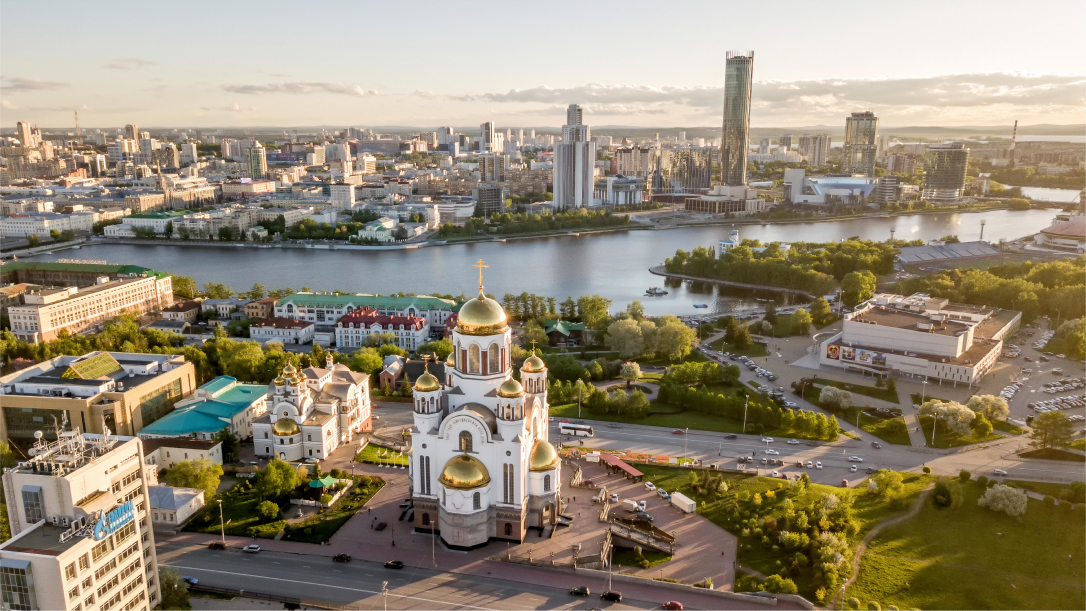EKATERINBURG IS LOCATED ON THE EASTERN SLOPE OF THE MIDDLE URALS, ON THE BANKS OF THE ISET RIVER. IT WAS FOUNDED ON NOVEMBER 18, 1723 AS AN IRONWORKS. IT WAS NAMED IN HONOR OF EMPRESS CATHERINE I. HOWEVER, THE STATUS OF A COUNTY CENTER OF THE PERM PROVINCE IT RECEIVED ALREADY UNDER THE REIGN OF CATHERINE II IN 1781.
EKATERINBURG IS THE LARGEST CITY ON THE LAND BORDER OF EUROPE AND ASIA. A UNIQUE GEOGRAPHICAL POINT IS LOCATED ONLY SEVENTEEN KILOMETERS FROM THE CITY CENTER. A MONUMENT IS INSTALLED THERE AND IT IS CONSIDERED ONE OF THE MOST VISITED PLACES OF EKATERINBURG.
Ekaterinburg is the most compact big city in Russia with population over one million citizens (by the way, the millionth resident was born here back in 1967). The length of the built-up territory of the capital of the Urals is 20 kilometers from north to south and 15 kilometers from west to east. The metro ride from the terminal North Station "Prospect Kosmonavtov" to the terminal South Station "Botanicheskaya" takes only 19 minutes.
From 1924 to 1991, the city was called Sverdlovsk, and the region, the center of which it is, still bears the name of Sverdlovsk region.
During the Great Patriotic War, the most powerful radio transmitter in the USSR was located in Sverdlovsk, and it was from here that the legendary Yuri Levitan read the bulletins “from the Soviet Information Bureau”. Also during the war, not only many factories were evacuated here, but also the Chekhov Moscow Art Theater, the Central Theater of the Red Army and the collections of the State Hermitage were housed in Sverdlovsk.

In general, the history of the city is rich in various unique facts and events. For example, in the 18th century, the Yekaterinburg Mint produced up to 80% of copper coins in the Russian Empire. A simple peasant Efim Artamonov assembled here the first bicycle, an analogue of modern models, on which he arrived at the coronation of Emperor Alexander I in St. Petersburg in 1801. On May 15, 1942, test pilot Grigory Bakhchivandzhi made a flight on the world's first BI-1 jet aircraft in the sky over Sverdlovsk.
Metallurgy played a special role in the history of Ekaterinburg. The city itself appeared due to the development of this industry, and it brought the world fame and glory to the Urals and its capital. It is no coincidence that the strongest and very high-quality Ural metal was used in the construction of many famous architectural structures in different parts of the globe. The roofs of the British Parliament and the Palace of Westminster in London are made of our roofing iron, the frame of the Statue of Liberty in New York is made of Ural copper, the Ural steel is present in the structures of the Eiffel Tower in Paris.
The following facts speak of the modern development of Ekaterinburg. In terms of gross regional product it gives in only to Moscow and St. Petersburg. It is the fourth most populated city in the country and it is included in the top 10 Russian cities with the highest standard of living. It ranks third in Russia in the number of cars, theaters and diplomatic missions. Two of the world's northernmost skyscrapers were built in Ekaterinburg: the Iset residential tower (209 m) and the Vysotsky business center (188 m).
Yekaterinburg is considered the birthplace of the first President of Russia Boris Yeltsin. Here he studied and began his political career. Opened in 2015, The Presidential Center named after B.N. Yeltsin (Yeltsin Center), today has become one of the main venues for various social, cultural and educational events.